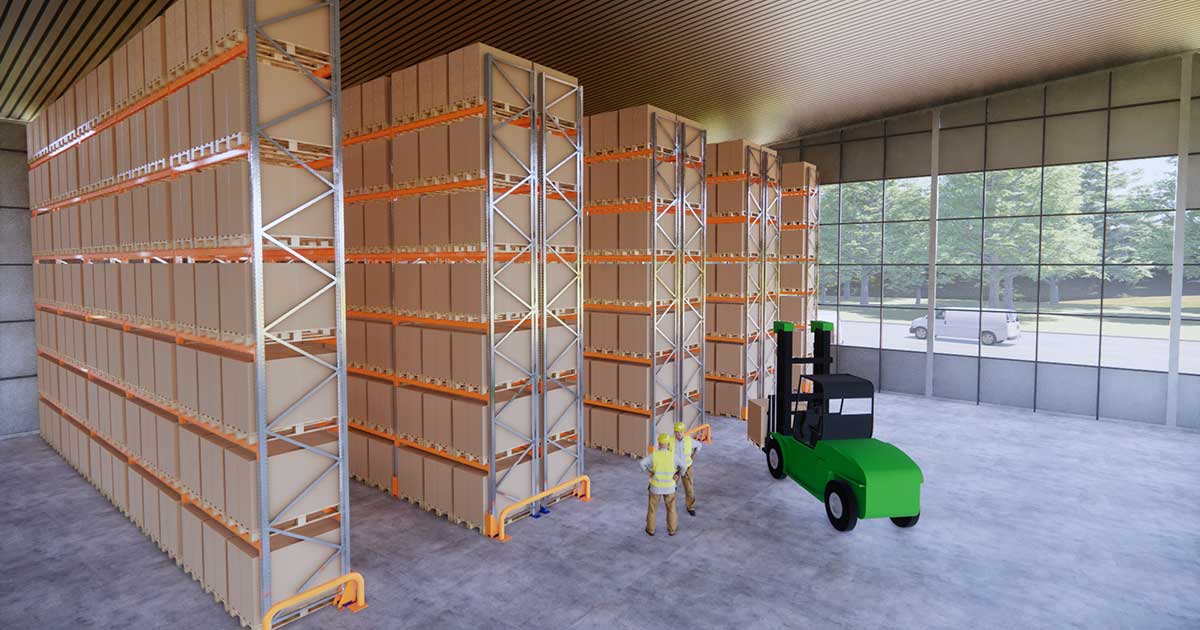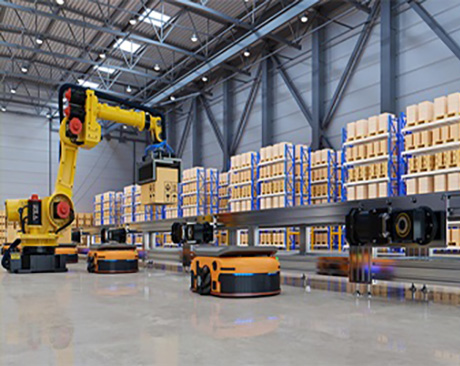What is a WMS System?
A WMS helps your team be more efficient, by making it easier to know where incoming items should be stored, and where to find stock that's due to leave.
Read More
13.12.2024
The warehousing industry plays a vital role in the global supply chain – as businesses strive towards a more sustainable future, incorporating eco-friendly practices becomes increasingly important.
Sustainability refers to the ability to meet present needs without compromising the ability of future generations to meet their own needs.
In the context of the warehousing industry, sustainability encompasses a range of practices that minimise environmental impact, optimise resource utilisation and prioritise social responsibility. These practices not only contribute to a healthier planet but also bring a host of benefits, both for businesses and the larger community.
Keep reading to explore various aspects of sustainability in warehousing operations. From energy-efficient warehouse design to eco-friendly packaging solutions, here we will delve into actionable strategies that help businesses reduce waste, lower carbon footprint, keep energy costs and create a more sustainable supply chain.
Join us on this journey towards a greener future for the warehousing industry, and discover how sustainable practices can propel your business towards success while having a positive impact on the planet.
Warehousing plays a crucial role in ensuring the sustainability of supply chain operations.
By definition, warehousing refers to the process of storing, handling, and managing inventory within a designated facility, serving as a strategic link between suppliers, manufacturers, retailers and consumers, ensuring the smooth flow of goods throughout the entire supply chain.

Warehousing is an integral part of supply chain management, as it enables efficient inventory management and order fulfilment. It involves activities such as receiving, storing, picking, packing, and shipping goods. Warehouse facilities act as distribution centres, providing a centralised location for storing products close to demand points.
Efficient warehousing reduces lead times, minimises stockouts, and optimises inventory levels, resulting in improved customer satisfaction and cost savings, as well as providing the necessary infrastructure and resources to support business growth and market expansion.
Warehousing operations have significant environmental and social impacts, including energy consumption, greenhouse gas emissions, waste generation, water usage, and workforce wellbeing and safety.
Traditional warehousing practices often involve excessive energy use, resulting in higher carbon emissions, largely due to inefficient layouts, lack of insulation and outdated heating and cooling systems – while wasteful packaging, improper waste disposal and limited recycling efforts lead to increased environmental degradation.
Warehousing operations also affect the social dimension of sustainability; workers may face health and safety risks due to inadequate safety measures and improper handling of hazardous materials. Poor working conditions and lack of employee welfare initiatives can negatively impact the overall well-being of both warehouse operators and staff.
After recognising the impact of warehouse sustainability, businesses are increasingly integrating sustainable practices into their warehousing operations. Sustainable warehousing aims to minimise the environmental footprint, improve resource efficiency, promote employee well-being and contribute to social responsibility.
By implementing sustainable warehousing practices, companies can improve their overall supply chain sustainability performance. Sustainable warehousing sustainability initiatives can not only reduce operational costs but also enhance brand reputation by demonstrating environmental and social responsibility:
Sustainable warehousing helps companies to align with global sustainability goals, such as the United Nations’ Sustainable Development Goals, and contributes to a more resilient and responsible supply chain.

In today’s world, sustainability has become a crucial aspect of every industry, including warehousing; as energy efficiency plays a vital role in reducing the environmental impact of warehousing operations. By optimising energy usage, warehouses can significantly contribute to creating a more sustainable future.
Warehouses are known for their high energy consumption due to round-the-clock operations, large indoor spaces, and heavy equipment usage, but implementing energy-efficient practices can help reduce carbon emissions and minimise the overall environmental impact.
One of the most effective ways to improve energy efficiency in warehouses is through the use of efficient lighting systems; upgrading traditional fluorescent lights to LED fixtures can lead to substantial energy savings, as LED lights consume less energy, have a longer lifespan, and produce better illumination – ultimately reducing both energy consumption and maintenance costs.
Heating, ventilation, and air conditioning (HVAC) systems play a significant role in a warehouse’s overall energy consumption. By using energy-efficient HVAC systems, warehouses can minimise energy consumption, minimise energy waste and reduce their carbon footprint. Implementing technologies such as automated controls, variable speed drives, and thermal insulation can optimise HVAC energy efficiency.

Adopting smart energy management systems and practices is crucial for optimising energy usage in warehouses. This could include the use of occupancy sensors to control lighting and HVAC systems, setting energy-efficient temperature and energy efficient lighting schedules, while investing in energy monitoring systems and solar panels in order to implement green warehousing practices and utilise natural light and resources for energy.
By effectively managing renewable energy and consumption, warehouses can reduce costs and environmental impact simultaneously.
In order to achieve sustainability in warehousing, waste reduction and recycling play a crucial role. By implementing strategies and programs to manage waste effectively, warehouses can minimise their environmental impact and contribute to a greener future.
Warehouses can adopt several strategies to manage waste efficiently – one approach is to conduct a waste audit to identify the types and quantities of waste generated. This audit can help warehouses devise targeted waste reduction plans such as:
In order to ensure effective waste management, it is essential for warehouses to sort waste materials properly and dispose of them in the appropriate manner. This includes separating recyclable materials from non-recyclable ones and disposing of hazardous waste safely.
When disposing of warehouse waste it is also vital to:
Warehouses can also promote composting and recycling programs as part of their waste reduction efforts. Composting organic waste can divert it from landfills and create nutrient-rich soil, while recycling materials such as paper, plastic, and metal can conserve resources and reduce the need for virgin materials.
You can promote composting and recycling in your warehouse operations by:
Increasing recycling rates in warehouses can have multiple benefits, both for the environment and the business itself. By diverting waste from landfills, warehouses can reduce greenhouse gas emissions and conserve natural resources – implementing recycling initiatives can also improve the image of the warehouse and attract environmentally conscious customers.

Transportation plays a major role in the supply chain and has a significant environmental impact on sustainability; it is important to adopt efficient transportation methods that reduce emissions and fuel consumption.
Businesses can explore alternative modes of transportation such as rail or waterways, which have a lower carbon footprint compared to road transportation, and consider optimising routes and loads for electric vehicles, which can further reduce fuel consumption and emissions.
One of the key strategies for achieving sustainability in warehousing is to minimise transportation distances; by locating warehouses closer to suppliers and customers, businesses can reduce the amount of fuel consumed and emissions produced during transportation.
Implementing just-in-time inventory management systems can help reduce the need for long-distance transportation and minimise wasted resources. This approach ensures that products are delivered to the warehouse in time to meet customer demand, eliminating unnecessary storage and other transportation costs.
Automation and advanced technologies have revolutionised the warehousing and logistics industry, offering numerous benefits when it comes to sustainability.
First and foremost, implementing automation reduces the reliance on manual labour, which means minimising the carbon footprint associated with human-intensive activities. By streamlining operations and eliminating repetitive tasks,warehouse automation also significantly enhances efficiency in supply chain logistics and the available warehouse space, while reducing energy consumption and therefore the impact on the environment.
Automated systems are designed to optimise storage space, allowing sustainable warehouses to store a larger volume of goods in a smaller footprint. This not only minimises the need for additional warehouse construction and therefore building materials but also reduces transportation requirements, resulting in fewer emissions and lower energy usage.
Robotic Process Automation (RPA) takes automation to the next level by employing robots to perform tasks traditionally done by humans. RPA enables repetitive tasks, such as sorting, picking, and packing, to be completed more efficiently and accurately.
By leveraging RPA, warehouses can achieve substantial energy savings as robots are programmed to operate with optimal energy usage – RPA also minimises errors and improves inventory accuracy, reducing waste and the environmental impact associated with incorrect orders or excess inventory. The use of robots in warehousing significantly decreases the risk of accidents and injuries, contributing to employee well-being and safety.

Artificial Intelligence (AI) has become a game-changer in warehouse inventory management, as AI algorithms analyse vast amounts of data to predict demand patterns, optimise stock levels, and improve overall inventory control and environmental sustainability.
By accurately forecasting demand, AI helps warehouses avoid overstocking, leading to a reduction in waste. AI-powered inventory management also enhances supply chain efficiency, minimising transportation and storage costs, and ultimately reducing the carbon footprint of the entire operation.
AI-driven inventory management systems can also optimise product placement within the warehouse, improving accessibility and greatly reducing travel distances, which not only increases operational efficiency but also lowers energy consumption associated with warehouse processes.
Implementing smart systems that monitor energy consumption and optimise processes is crucial for sustainable warehousing. These systems use sensors and IoT technology to collect and analyse real-time data, enabling warehouses to identify and address energy inefficiencies.
Smart systems support predictive maintenance, allowing warehouses to detect and address equipment issues promptly; not only improving operational efficiency but also prolonging equipment lifespan, reducing the environmental impact related to frequent replacements.
With the integration of automation and advanced technologies, sustainable warehousing becomes an achievable goal. By eliminating waste, optimising processes, and reducing energy consumption, automation and technology drive sustainability in warehouses, setting a new standard for the industry.
Sustainability in warehousing goes beyond the warehouse itself. It is essential for warehouse designers , owners and workers to consider the environmental impacts of all stages of the supply chain, from sourcing raw materials to delivering finished products.
Businesses often strive to work with suppliers and prioritise sustainability and ethical practices. This includes sourcing materials from environmentally responsible sources and adopting sustainable manufacturing processes.
If you want to make your warehouse sustainable and improve your warehouse management system contact the experts at SEC Group today; we can help with implementing warehousing technologies and environmentally friendly practices into your warehouse layout to reduce energy consumption, waste production, and make the most of your available space.
A WMS helps your team be more efficient, by making it easier to know where incoming items should be stored, and where to find stock that's due to leave.
Read MoreThis is our take on the benefits of AI in warehousing in the next few years.
Read MoreMaking a workspace sustainable is all about finding ways to reduce our reliance on resources, without compromising the efficiency and effectiveness of our businesses.
Read More